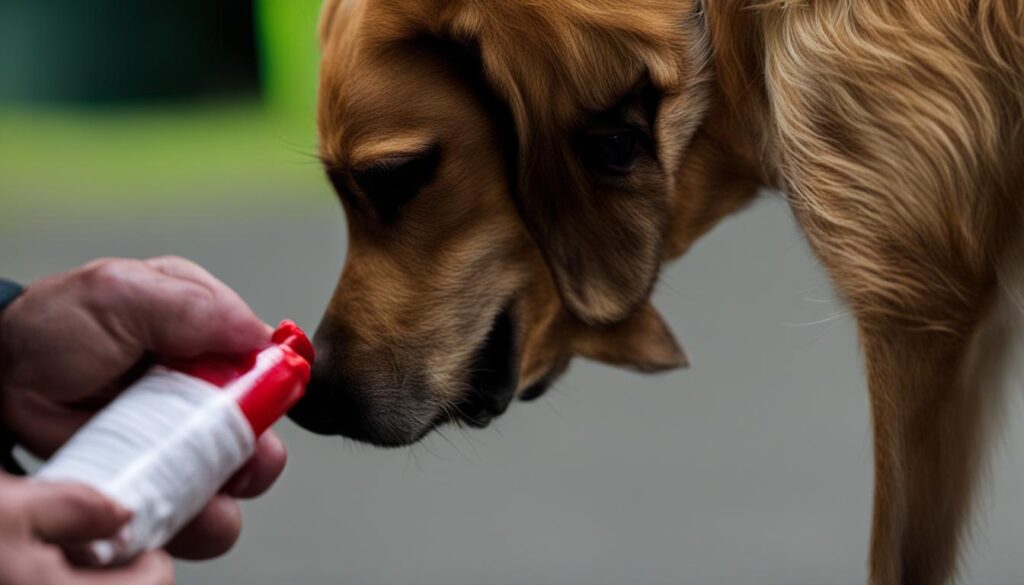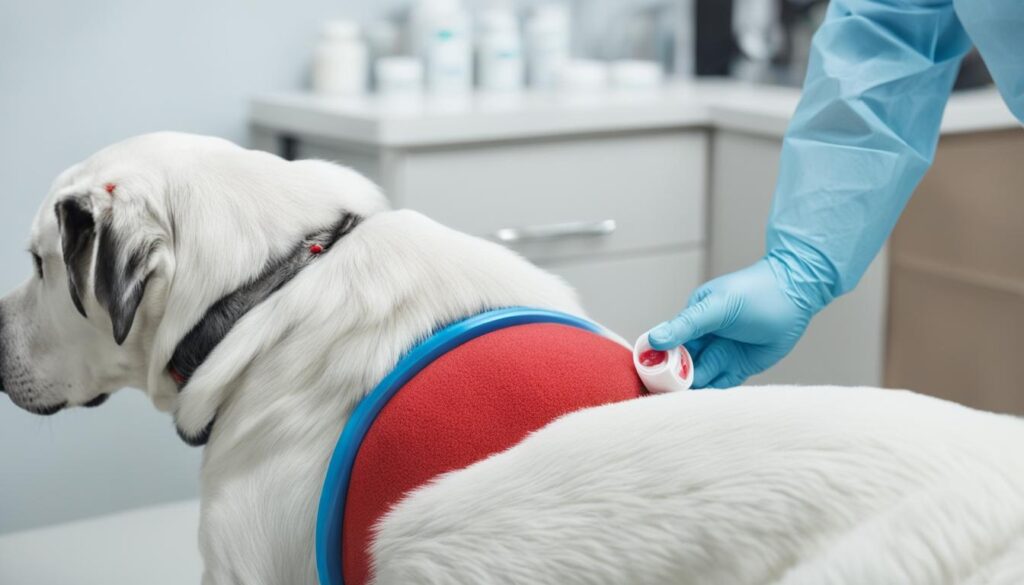Why is my Dog’s Anus Red, Swollen, and Itchy?
A dog’s red, swollen, and itchy anus can be a cause for concern. It is important to understand the underlying causes and find ways to provide relief for your pet. In this article, we will explore the common causes of dog anal redness and swelling, including anal sac disease, yeast infections, perianal fistula, and more. We will also discuss treatment options and preventive measures to keep your dog’s anus healthy.
Key Takeaways:
- Redness, swelling, and itchiness in a dog’s anus can indicate underlying health issues.
- Common causes of dog anal redness and swelling include anal sac disease, yeast infections, and perianal fistula.
- Regular cleaning and grooming, along with a balanced diet, can contribute to a healthy anus.
- Knowing the symptoms and when to seek veterinary care is crucial for your dog’s well-being.
- Treatment options may include cleaning the anal glands, medications, and surgical removal in some cases.
Understanding Your Dog’s Rectal Health
Taking care of your dog’s rectal health is essential for their overall well-being. Monitoring the health of their anus can help detect any abnormalities or discomfort early on. Regular cleaning and grooming of the anal area, along with a balanced diet, can contribute to a healthy anus. Paying attention to any redness, swelling, or discharge around the anus is important, as it can be a sign of underlying health issues.
Your dog’s rectal health plays a vital role in their overall comfort and quality of life. By understanding the importance of dog rectal health and being proactive in its maintenance, you can ensure that your furry friend stays happy and healthy.
Regular cleaning and grooming of the anal area is essential for preventing issues that can arise from poor rectal hygiene. This includes removing any fecal residue and ensuring that the area is kept clean and dry. Gently wiping the area with a damp cloth or using pet-safe wipes can help maintain cleanliness.
In addition to regular cleaning, it’s crucial to provide your dog with a balanced diet. A diet rich in fiber can promote healthy bowel movements and reduce the risk of constipation or diarrhea, which can contribute to rectal discomfort. Consult with your veterinarian to determine the appropriate diet for your dog’s specific needs.
It’s also important to be aware of any signs of rectal issues in your dog. Redness, swelling, or discharge around the anus may indicate the presence of infection, inflammation, or other underlying health conditions. If you notice any abnormal symptoms, it’s advisable to consult with your veterinarian for a proper diagnosis and treatment plan.
By prioritizing your dog’s rectal health and taking preventative measures, you can help mitigate the risk of rectal issues and ensure that your furry friend stays comfortable and happy.
Causes of Redness or Inflammation
Redness and inflammation in a dog’s anus can be caused by various factors. Understanding these causes is essential for effectively addressing the issue and providing relief for your furry friend.
Anal sac disease: This condition occurs when the anal sacs, which are small glands located on either side of the anus, become infected or impacted. It can lead to discomfort, swelling, and redness in the anal area.
Yeast infections: Fungal overgrowth can cause irritation and redness in the anus. This is often accompanied by itching and a foul odor.
Perianal fistula: This is a painful condition characterized by the formation of deep ulcers and fistulas around the anus. It can lead to swelling, inflammation, and redness in the affected area.
Rectal prolapse: When the rectal tissue protrudes through the anus, it can cause redness, swelling, and discomfort. This condition is often associated with straining during bowel movements or underlying medical issues.
Perianal tumors: Tumors that develop in or around the anus can cause redness, swelling, and discomfort. They can be benign or malignant and may require surgical intervention.
Foreign bodies or injuries: Objects lodged in the anus or injuries to the anal area can lead to inflammation and redness. These may include foreign objects, trauma, or self-induced irritation from excessive licking or biting.
Parasites (worms): Certain parasites, such as tapeworms or pinworms, can cause irritation, redness, and swelling in the anal area. Regular deworming is vital to prevent parasitic infestations.
Perianal hernia: A perianal hernia occurs when the muscles around the anus weaken, causing the rectal tissue to bulge. This can result in redness, swelling, and discomfort.
Rectal tumors: Tumors that develop within the rectum can cause inflammation and redness in the anal area. These tumors may be benign or malignant and often require surgical intervention.
Rectal polyps: Polyps are abnormal tissue growths that can develop in the rectum. They can cause irritation, redness, and swelling in the anal area.
Rectal tears: Tears or fissures in the anal canal can result from trauma or straining during bowel movements. They can lead to redness, swelling, and discomfort.
Birth rectal defects: Some dogs may be born with congenital rectal abnormalities, such as malformations or strictures, which can cause redness, swelling, and irritation in the anal area.
Identifying the specific cause of redness and swelling in your dog’s anus is crucial for implementing appropriate treatment. Consult with your veterinarian to determine the underlying condition and develop a tailored treatment plan.
Common Symptoms to Look Out For
As a responsible dog owner, it’s important to be attentive to your furry friend’s health. When it comes to anal redness and swelling, there are several symptoms that you should be on the lookout for. Recognizing these signs can help you seek proper veterinary care and ensure the well-being of your beloved pet.
- Scooting: Your dog may repeatedly drag their bottom across the ground or a surface in an attempt to alleviate discomfort.
- Licking or Biting the Anus: Excessive licking or biting of the anal area can indicate irritation or itching.
- Foul Odor: If you notice an unpleasant smell coming from your dog’s anus, it could be a sign of infection or other underlying issues.
- Discharge: Abnormal discharge, such as pus or blood, from the anus should not be ignored and requires prompt veterinary attention.
- Visible Sores or Bleeding: Any visible sores or bleeding around the anus should be taken seriously and checked by a veterinarian.
- Pain or Discomfort During Defecation: If your dog seems to experience pain or discomfort while passing stool, it could be related to anal redness and swelling.
- Swelling or Inflammation of the Anus: Obvious swelling or inflammation in the anal area can be a visual cue of an underlying problem.
If you observe any of these symptoms in your dog, it is crucial to consult with a veterinarian. They can provide a proper diagnosis and recommend appropriate treatment options to alleviate your dog’s anal discomfort.

Immediate Home Remedies
While it’s always important to consult a veterinarian for proper diagnosis and treatment, there are some immediate home remedies that can provide temporary relief for a dog’s anal discomfort. These remedies may include:
- Gently cleaning the anal area with a damp cloth.
- Providing a balanced diet with fiber to promote regular bowel movements.
- Avoiding harsh cleaning products.
- Ensuring your dog gets enough exercise.
By following these simple home remedies, you can help alleviate some of the symptoms of dog anal itching and discomfort, as well as provide relief for dog anal swelling. Remember, these remedies are not a substitute for veterinary care, so be sure to consult a professional for a proper diagnosis and treatment plan.
When to Visit the Vet
It’s crucial to know when it’s time to seek veterinary care for your dog’s anal redness and swelling. While some cases of mild discomfort can be addressed with home remedies, certain symptoms warrant immediate attention from a professional veterinarian. If your dog’s anal redness and swelling persist or worsen, if there is severe pain or discomfort, if you notice bleeding or discharge, or if your dog seems distressed or unable to defecate, it is important to schedule a visit with your veterinarian. Remember, only a professional can properly diagnose the underlying cause and provide appropriate treatment for your furry friend.
Treatment Options
The treatment for dog anal redness and swelling will depend on the underlying cause. Your veterinarian will assess the situation and recommend the appropriate course of action based on the diagnosis and severity of your dog’s condition.
Cleaning and Expression of Anal Glands: In cases where the anal glands are the primary cause of redness and swelling, your veterinarian may perform a procedure to clean and express the glands. This helps to alleviate the discomfort and reduce inflammation.
Topical or Oral Medications: For infections or yeast overgrowth, your veterinarian may prescribe topical creams or ointments to be applied to the affected area. In more severe cases, oral medications such as antibiotics or antifungals may be necessary to eliminate the infection.
Surgical Removal of Tumors or Polyps: If tumors or polyps are causing the anal redness and swelling, surgical intervention may be required. Your veterinarian will determine the best approach and discuss the potential risks and benefits of the procedure.
Management of Underlying Conditions: In some cases, anal redness and swelling may be a symptom of an underlying condition such as allergies. Your veterinarian may prescribe medications or recommend dietary changes to manage the root cause and prevent future incidents.
It’s important to follow your veterinarian’s instructions carefully and complete the full course of treatment to ensure the best possible outcome for your dog’s anal health.
Treatment Options Overview
| Treatment Option | Description | Effectiveness |
|---|---|---|
| Cleaning and Expression of Anal Glands | Procedure to cleanse and empty anal glands | Effective for anal gland-related issues |
| Topical or Oral Medications | Application of creams or ointments; oral administration of antibiotics or antifungals | Effective for infections and yeast overgrowth |
| Surgical Removal of Tumors or Polyps | Surgical intervention to remove abnormal growths | Effective for tumors or polyps causing redness and swelling |
| Management of Underlying Conditions | Medications or dietary changes to address underlying health issues | Effective for managing the root cause |

Preventive Measures
Taking preventive measures is essential for maintaining your dog’s anal health and preventing issues such as redness and swelling. By following these simple dog anus health tips and practicing good dog anal hygiene, you can ensure your furry friend stays comfortable and free from discomfort.
Regular Cleaning and Grooming
Proper cleaning and grooming of the anal area are crucial to prevent dog anal redness and swelling. Use a mild, pet-safe cleanser to gently clean the area around the anus. Avoid using harsh or scented cleaning products, as they can irritate the sensitive skin. Regular grooming, including trimming the hair surrounding the anus, can also help prevent fecal matter from getting trapped and causing irritation.
Balanced Diet with Adequate Fiber
A well-balanced diet plays a significant role in maintaining your dog’s overall health, including their anal health. Ensure that your dog’s diet consists of high-quality, fiber-rich food. Adequate fiber promotes regular bowel movements and prevents constipation, which can contribute to anal discomfort and inflammation.
Avoid Harsh Cleansers
When caring for your dog’s anal area, it’s important to avoid using harsh cleansers or wipes. These can strip away the natural oils and disrupt the delicate balance of the skin, leading to dryness and irritation. Opt for gentle cleansers specifically formulated for dogs or seek advice from your veterinarian on suitable products.
Promote Regular Exercise
Regular exercise is not only beneficial for your dog’s overall well-being but also for their anal health. Exercise helps stimulate proper bowel movements and prevents constipation, reducing the risk of anal swelling and discomfort. Engage your dog in activities such as daily walks or playtime to encourage regular exercise.
Conclusion
Maintaining good anal health is crucial for our furry friends. Dogs can experience anal redness and swelling, which can be uncomfortable and distressing for them. By understanding the causes and symptoms of these issues, pet owners can take the necessary steps to provide care and relief for their dogs.
Anal redness and swelling in dogs can be caused by various factors, including anal sac disease, yeast infections, perianal fistula, and more. It is important to be proactive in monitoring the health of your dog’s anus and seek veterinary care if you notice any signs of discomfort or abnormalities.
Treatment options for dog anal redness and swelling may include cleaning and expression of the anal glands, topical or oral medications, and in some cases, surgical intervention. Working closely with a veterinarian is crucial to determine the underlying cause and provide appropriate treatment.
Prevention is also key to maintaining good anal health in dogs. Regular cleaning and grooming of the anal area, a balanced diet, and avoiding harsh cleaning products can help prevent issues like redness and swelling. Additionally, providing regular exercise to promote healthy bowel movements can contribute to overall anal health.
By being diligent in monitoring anal health, seeking veterinary care when needed, and taking preventive measures, dog owners can ensure the well-being of their beloved pets and help keep their anal area healthy and comfortable.
FAQ
Why is my dog’s anus red, swollen, and itchy?
A dog’s red, swollen, and itchy anus can be caused by various factors such as anal sac disease, yeast infections, perianal fistula, rectal prolapse, perianal tumors, foreign bodies or injuries, parasites (worms), perianal hernia, rectal tumors, rectal polyps, rectal tears, and birth rectal defects. It’s important to seek veterinary care for proper diagnosis and treatment.
How can I take care of my dog’s rectal health?
To maintain your dog’s rectal health, it is important to regularly clean and groom the anal area, ensure a balanced diet with proper fiber content, avoid harsh or scented cleaning products, and provide regular exercise to promote good bowel movements.
What are the common causes of redness or inflammation in a dog’s anus?
The common causes of anal redness and swelling in dogs can include anal sac disease, yeast infections, perianal fistula, rectal prolapse, perianal tumors, foreign bodies or injuries, parasites (worms), perianal hernia, rectal tumors, rectal polyps, rectal tears, and birth rectal defects.
What symptoms should I look out for if my dog has anal redness and swelling?
Symptoms of anal redness and swelling in dogs can include scooting, licking or biting the anus, foul odor, discharge, visible sores or bleeding, pain or discomfort during defecation, and swelling or inflammation of the anus.
Are there any immediate home remedies for dog anal discomfort?
While it’s always important to consult a veterinarian, some immediate home remedies that can provide temporary relief for a dog’s anal discomfort include gently cleaning the anal area with a damp cloth, providing a balanced diet with fiber to promote regular bowel movements, avoiding harsh cleaning products, and ensuring your dog gets enough exercise.
When should I visit the vet for my dog’s anal redness and swelling?
It’s important to visit the veterinarian if the symptoms persist or worsen, if there is severe pain or discomfort, if there is bleeding or discharge, or if your dog seems distressed or unable to defecate.
What are the treatment options for dog anal redness and swelling?
Treatment options for dog anal redness and swelling will vary depending on the underlying cause. Treatment may involve cleaning and expression of the anal glands, topical or oral medications for infections or yeast overgrowth, surgical removal of tumors or polyps, and management of underlying conditions such as allergies.
How can I prevent dog anal redness and swelling?
To prevent dog anal redness and swelling, it is important to maintain regular cleaning and grooming of the anal area, ensure a balanced diet with proper fiber content, avoid harsh or scented cleaning products, and provide regular exercise to promote good bowel movements.
How can I summarize the importance of dog anal health?
Taking care of your dog’s anal health is essential for their overall well-being. Monitoring the health of their anus can help detect any abnormalities or discomfort early on. By being proactive in monitoring anal health and seeking veterinary care when needed, you can ensure the well-being of your beloved pet.


